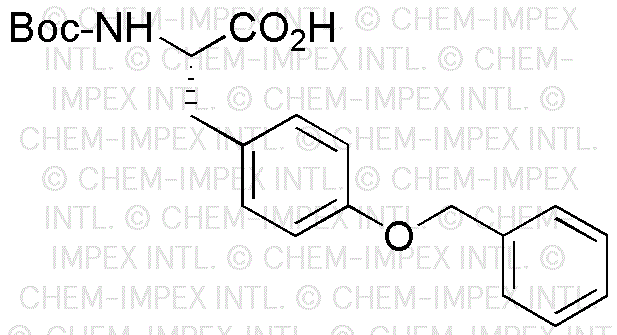Boc-O-benzyl-L-tyrosine is widely utilized in research focused on:
- Peptide Synthesis: This compound serves as a protective group in the synthesis of peptides, allowing for the selective modification of amino acids. Its stability under various conditions makes it a preferred choice for chemists.
- Drug Development: In pharmaceutical research, it is used to create more effective drug candidates by modifying the structure of biologically active peptides, enhancing their efficacy and stability.
- Bioconjugation: The compound can be employed in bioconjugation processes, linking biomolecules to therapeutic agents, which is crucial in developing targeted therapies in oncology and other fields.
- Research in Neuroscience: It is used in studies involving neurotransmitter systems, particularly in the development of compounds that can influence dopamine pathways, which are vital in treating disorders like Parkinson's disease.
- Material Science: The compound finds applications in creating functionalized polymers and materials, which can be used in drug delivery systems, enhancing the performance of medical devices.
General Information
Properties
Safety and Regulations
Applications
Boc-O-benzyl-L-tyrosine is widely utilized in research focused on:
- Peptide Synthesis: This compound serves as a protective group in the synthesis of peptides, allowing for the selective modification of amino acids. Its stability under various conditions makes it a preferred choice for chemists.
- Drug Development: In pharmaceutical research, it is used to create more effective drug candidates by modifying the structure of biologically active peptides, enhancing their efficacy and stability.
- Bioconjugation: The compound can be employed in bioconjugation processes, linking biomolecules to therapeutic agents, which is crucial in developing targeted therapies in oncology and other fields.
- Research in Neuroscience: It is used in studies involving neurotransmitter systems, particularly in the development of compounds that can influence dopamine pathways, which are vital in treating disorders like Parkinson's disease.
- Material Science: The compound finds applications in creating functionalized polymers and materials, which can be used in drug delivery systems, enhancing the performance of medical devices.
Documents
Safety Data Sheets (SDS)
The SDS provides comprehensive safety information on handling, storage, and disposal of the product.
Product Specification (PS)
The PS provides a comprehensive breakdown of the product’s properties, including chemical composition, physical state, purity, and storage requirements. It also details acceptable quality ranges and the product's intended applications.
Certificates of Analysis (COA)
Search for Certificates of Analysis (COA) by entering the products Lot Number. Lot and Batch Numbers can be found on a product’s label following the words ‘Lot’ or ‘Batch’.
Numéro de catalogue
Numéro de lot/série
Certificates Of Origin (COO)
This COO confirms the country where the product was manufactured, and also details the materials and components used in it and whether it is derived from natural, synthetic, or other specific sources. This certificate may be required for customs, trade, and regulatory compliance.
Numéro de catalogue
Numéro de lot/série
Safety Data Sheets (SDS)
The SDS provides comprehensive safety information on handling, storage, and disposal of the product.
DownloadProduct Specification (PS)
The PS provides a comprehensive breakdown of the product’s properties, including chemical composition, physical state, purity, and storage requirements. It also details acceptable quality ranges and the product's intended applications.
DownloadCertificates of Analysis (COA)
Search for Certificates of Analysis (COA) by entering the products Lot Number. Lot and Batch Numbers can be found on a product’s label following the words ‘Lot’ or ‘Batch’.
Numéro de catalogue
Numéro de lot/série
Certificates Of Origin (COO)
This COO confirms the country where the product was manufactured, and also details the materials and components used in it and whether it is derived from natural, synthetic, or other specific sources. This certificate may be required for customs, trade, and regulatory compliance.


